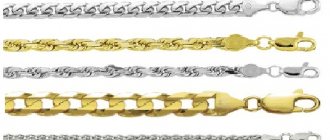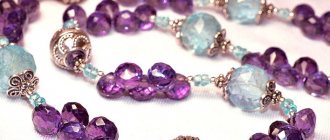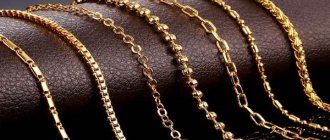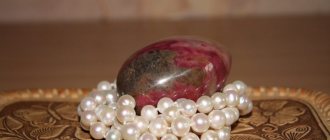Weaving "rhombus"
A type of armor weaving in which diamond-shaped links intersect one into another. Depending on the number of links intersecting each other, single, double and triple diamonds can be distinguished. This is perhaps the most universal weaving that looks great, regardless of the age and gender of the person.
Advertising - Continued below
Weaving "nonna"
Contrary to popular belief, the name of the chain weaving has nothing to do with the name Nonna, but comes from the French phrase “grandmother’s weaving,” which sounds like “maglia della nonna.” With this type of weaving, the chain consists of small links enclosed within large ones. This type of decoration can be chosen as an elegant evening option.
Chain care
If you wear it every day or put it on “on occasion,” the chain will still get dirty sooner or later. And the more complex and elaborate the weaving, the faster this will happen. Dirt, sweat, and sebum accumulate in the links and between them, and soft gold inevitably gets scratched, no matter how carefully you wear the jewelry. The chain darkens and doesn’t look so impressive.
To make your jewelry last longer, you need to follow a few simple rules when wearing it.
- First of all, compare the size of the pendant and the gold “cord”: a pendant that is too heavy will easily deform the links of the chain. Try to keep the weight of the pendant maximum equal to the weight of the chain itself.
- For the same reason (to avoid deformation or breakage of the product), it is recommended to remove the jewelry at night. This is especially true for thin openwork chains and for cobra-type weaving.
- If possible, do not forget to treat the chain with cleaning agents, since contact with the skin may darken it and lose its original appearance. You can use improvised means. Thus, light stains can be easily removed with toothpaste or even simple soapy water. Experts advise using a soft brush for this, and after placing the product in water, shake the container from time to time. This method will help softened lumps of dirt to free themselves from tightly closed chain links.
If you do not trust popular advice, purchase gold cleaning products at the store and make it a rule to use them regularly.
The skill of jewelers gives us an almost limitless number of chain weaving technologies. The imagination and experience of a specialist, tied together, guarantee that each of us will be able to choose a piece of jewelry to suit our taste, taking into account our appearance, lifestyle and the state of our wallet. We brought to your attention only the most popular types of weaving. But surely right now some inspired jeweler is inventing another knitting, which is in a hurry to complement our Top 20 and become twenty-first on this list.
"Snake" or jewelry cord
Weaving with a round cross-section. This bracelet is hollow in the middle and, thanks to the light zigzag effect, really resembles a snake. “Snakes” come in very different lengths and thicknesses, which allows you to choose an option for both women and men.
However, they still deserved more attention from the fair sex. Often such chains, especially thicker ones, are used as a full replacement for necklaces. By the way, the latter also come in different lengths, and their type and purpose depend on this characteristic. Chokers, collars, matinees - you can learn more about all types of necklaces in this article.
Advertising - Continued below
Figaro chain
Jewelry in the Figaro style is similar to those made in the armored design. Because of this, they are often confused. Meanwhile, the difference is quite obvious - the chains under consideration are heterogeneous. Main features of weaving:
- the links lie in the same plane;
- they vary in size.
In classic decoration, elements alternate - one large one follows several small ones. This results in a distinctive, recognizable and often very individual design.
The rather high complexity of the work determines the considerable price of such jewelry. By the way, they are intended exclusively for men.
The products are distinguished by:
- wearability;
- practicality;
- not an eyesore sophistication.
There is only one drawback - the links often get twisted.
Bismarck weave
Just like “perlina”, “Bismarck” weaving is not included in any group, and yet it is very common. This is a series of complex links, which themselves consist of smaller multidirectional links.
Advertising - Continued below
By the way, often simply choosing a nice chain weave is not enough. After all, decoration can be of different thicknesses and different lengths. And here a lot still depends on which one will suit you personally to your appearance in order to emphasize it as beneficially as possible. Read our article about choosing a necklace and chain to match your appearance!
Main differences
Before you decide how chains differ from each other and which knitting option is preferable for you, let's make a few preliminary notes about making metal jewelry.
Methods for making chains
First of all, let's pay attention to the fact that each chain can be made using machines (this happens most often) or by hand. If we are talking about machine weaving, then with this option the blanks are placed in special machines, where future links (no more than 0.2 mm thick) and their connections are formed.
But there are types of chains that cannot be completed without involving the talented hands of a specialist. In some regions, such professionals are called not jewelers, but chain makers - in the old fashioned way. In this case, almost everything except the quality of the precious metal depends on the professionalism of the jeweler.
The work of a chain maker is truly difficult and responsible. Imagine:
- first he draws out the gold wire and winds it around the base;
- a spiral is formed, which the jeweler, using special tools, cuts into small rings - links;
- these elements are also connected to each other without the help of a machine, but only thanks to pliers and the hands of a master;
- the resulting links are soldered for strength and then driven between presses to obtain the flat appearance we are accustomed to.
There is another option for making chains - stamping. In this case, the links themselves are already ready, stamped. The jeweler's job is to thread one die into another and secure them. Such jewelry is cheaper. True, experienced buyers try to purchase them only as a last resort. The method is, of course, simple. But it’s difficult to call such a product durable. Its elements are easily twisted and ultimately deformed. Therefore, it is believed that the first and second technologies are much preferable.
Which chain to choose - solid or hollow?
This is also a very important question that you need to decide before purchasing the product. It’s easy to guess that hollow chains are much lighter than their solid counterpart. At the same time, they may look more voluminous. Such decorations are distinguished by affordable prices and will delight you with the fantasy of weaving. True, hollow jewelry laces have one obvious disadvantage - their strength. Or rather, its absence. Lightweight products tend to deform faster. They are easier to tear. But they are simply not suitable for constant daily wear.
If you are sure that this is a product made of solid gold, remember: it will cost more and will feel heavier on your hand or neck. But the durability of such jewelry is legendary. They are not subject to deformation, you do not risk accidentally breaking them, and if necessary (if one or more links are damaged), the jeweler can easily solder the chain, which will look like new.
Byzantine or royal weaving
The “little brother” of the Bismarck weave. Another name is “fox tail”. It is used for massive bracelets and chains. Byzantine weaving consists of links of the same type, sequentially connected into patterns.
Of course, knowing what this or that chain weaving is called is useful both for self-education and from a practical point of view. So, you can always contact a jeweler and make a custom-made chain of exactly the length and thickness that you need. The same goes for earrings: if you want to choose a beautiful pair that will be comfortable to wear, find out what types of locks there are and what they are called.
How to choose a lock for a chain
If you have already decided on the type of weaving, it’s time to choose a lock for your future chain. This small element is not inferior in importance to the entire decoration. The types of locks in some places differ greatly from each other, and your task is not only to check the quality of workmanship, but also to pay attention to ease of use. Ideally, you yourself, without outside help, should be able to fasten and unfasten the lock and put on/take off any pendants and pendants.
The jeweler who makes the chains himself determines certain types of locks that will be appropriate in each specific case. The most popular today are:
- carbine - a small loop with a spring-loaded lock that snaps into place when it gets inside the ring;
- spring lock - a small round structure with a spring mechanism.
Functionally, there are no differences between them (both serve to fix jewelry and have a similar principle of operation), the level of ease of use and reliability of the design are also approximately equal. Traditionally, more massive and voluminous products are equipped with a carabiner, but for elegant narrow chains, an almost weightless spring lock would be more appropriate. Both of these structures can be repaired if necessary and are generally extremely reliable. But they are not without their drawbacks: for example, a large carabiner will stand out very much against the background of thin openwork weaves, and fastening it can be difficult if you have long nails. But the carbine will cope perfectly with the need to “add” a massive pendant to a chain without breaking. And a spring lock, due to its miniature size, would be most appropriate on the thinnest product.
There are several other types of fasteners, for example, figure eight, box or hinged. But they are used extremely rarely due to their low reliability or special specificity.
Which chain is suitable for a man and a woman?
It is worth noting that there are typically female and typically male types of weaving. Thus, men are recommended to pay attention to the “bismarck”, wide armor weave and “diamond”. And for women, Venetian weaving, “lava” and “nonna” chains are suitable. At the same time, a chain made using the “python” technique – a type of male “Bismarck” – will also look great on a woman.
As for the length of the chain, for a woman a universal option would be a chain of 45-50 cm; for men, in most cases, chains of 55-60 cm will be more convenient. Although, of course, everyone should choose the option that will be as comfortable as possible and will suit the chosen image and fashion style. For example, you can find out what jewelry etiquette allows you to wear in the office in our article.
How are men's chains different from women's?
The difference is quite significant, although some models belong to the “unisex” category. In order not to doubt the product you chose in the store, I recommend remembering the rule. Men's chains can only be short (but not less than 50 cm!) or medium length (that is, they do not fall along the torso), they must be thick (from 7 mm) or medium thickness (from 4-5 mm). There is no enamel or inlay on men's chains.
The most popular among both men and women are thin chains of medium length. This is considered a classic, versatile neck chain option.









